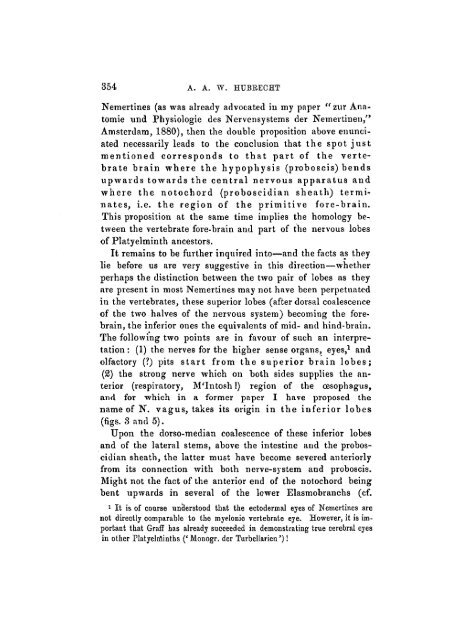On the Ancestral Form of the Chordata.
On the Ancestral Form of the Chordata.
On the Ancestral Form of the Chordata.
Create successful ePaper yourself
Turn your PDF publications into a flip-book with our unique Google optimized e-Paper software.
354 A. A. W. HUBEECHT<br />
Nemertines (as was already advocated in my paper " zur Anatomie<br />
und Physiologie des Nervensystems der Nemertinen,"<br />
Amsterdam, 1880), <strong>the</strong>n <strong>the</strong> double proposition above enunciated<br />
necessarily leads to <strong>the</strong> conclusion that <strong>the</strong> spot just<br />
mentioned corresponds to that part <strong>of</strong> <strong>the</strong> vertebrate<br />
brain where <strong>the</strong> hypophysis (proboscis) bends<br />
upwards towards <strong>the</strong> central nervous apparatus and<br />
where <strong>the</strong> notochord (proboscidian sheath) terminates,<br />
i.e. <strong>the</strong> region <strong>of</strong> <strong>the</strong> primitive fore-brain.<br />
This proposition at <strong>the</strong> same time implies <strong>the</strong> homology between<br />
<strong>the</strong> vertebrate fore-brain and part <strong>of</strong> <strong>the</strong> nervous lobes<br />
<strong>of</strong> Platyelminth ancestors.<br />
It remains to be fur<strong>the</strong>r inquired into—and <strong>the</strong> facts as <strong>the</strong>y<br />
lie before us are very suggestive in this direction—whe<strong>the</strong>r<br />
perhaps <strong>the</strong> distinction between <strong>the</strong> two pair <strong>of</strong> lobes as <strong>the</strong>y<br />
are present in most Nemertines may not have been perpetuated<br />
in <strong>the</strong> vertebrates,, <strong>the</strong>se superior lobes (after dorsal coalescence<br />
<strong>of</strong> <strong>the</strong> tvvo halves <strong>of</strong> <strong>the</strong> nervous system) becoming <strong>the</strong> forebrain,<br />
<strong>the</strong> inferior ones <strong>the</strong> equivalents <strong>of</strong> mid- and hind-brain.<br />
The following two points are in favour <strong>of</strong> such an interpretation:<br />
(1) <strong>the</strong> nerves for <strong>the</strong> higher sense organs, eyes, 1 and<br />
olfactory (?) pits start from <strong>the</strong> superior brain lobes;<br />
(2) <strong>the</strong> strong nerve which on both sides supplies <strong>the</strong> anterior<br />
(respiratory, M'Intosh!) region <strong>of</strong> <strong>the</strong> oesophagus,<br />
and for which in a former paper I have proposed <strong>the</strong><br />
name <strong>of</strong> N. vagus, takes its origin in <strong>the</strong> inferior lobes<br />
(figs. 3 and 5).<br />
Upon <strong>the</strong> dorso-median coalescence <strong>of</strong> <strong>the</strong>se inferior lobes<br />
and <strong>of</strong> <strong>the</strong> lateral stems, above <strong>the</strong> intestine and <strong>the</strong> proboscidian<br />
sheath, <strong>the</strong> latter must have become severed anteriorly<br />
from its connection with both nerve-system and proboscis.<br />
Might not <strong>the</strong> fact <strong>of</strong> <strong>the</strong> anterior end <strong>of</strong> <strong>the</strong> notochord being<br />
bent upwards in several <strong>of</strong> <strong>the</strong> lower Elasmobranchs (cf.<br />
1<br />
It is <strong>of</strong> course understood that <strong>the</strong> ectodermal eyes <strong>of</strong> Nemertines are<br />
not directly comparable to <strong>the</strong> myelonic vertebrate eye. However, it is important<br />
that Graff has already succeeded in demonstrating true cerebral eyes<br />
in o<strong>the</strong>r Platyelrflinths ('Monogr. der Turbellarien'}!

















